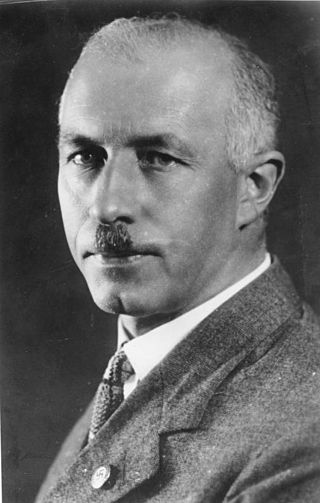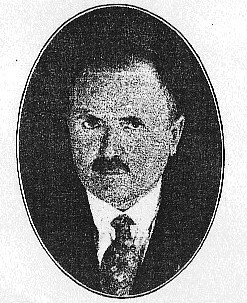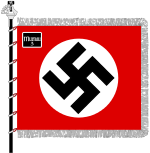The German Labour Front was the national labour organization of the Nazi Party, which replaced the various independent trade unions in Germany during the process of Gleichschaltung or Nazification.

Gottfried Feder was a German civil engineer, a self-taught economist, and one of the early key members of the Nazi Party and its economic theoretician. One of his lectures, delivered on 12 September 1919, drew Adolf Hitler into the party.

Theodor Adrian von Renteln was an activist and politician in Nazi Germany. During World War II, he was General Commissioner of Generalbezirk Litauen and was involved in perpetrating the Holocaust in Lithuania.

Austrian Nazism or Austrian National Socialism was a pan-German movement that was formed at the beginning of the 20th century. The movement took a concrete form on 15 November 1903 when the German Worker's Party (DAP) was established in Austria with its secretariat stationed in the town of Aussig. It was suppressed under the rule of Engelbert Dollfuss (1932–34), with its political organization, the DNSAP banned in early 1933, but was revived and made part of the German Nazi Party after the German annexation of Austria in 1938.
This is a list of words, terms, concepts and slogans of Nazi Germany used in the historiography covering the Nazi regime. Some words were coined by Adolf Hitler and other Nazi Party members. Other words and concepts were borrowed and appropriated, and other terms were already in use during the Weimar Republic. Finally, some are taken from Germany's cultural tradition.

Ernst Klee was a German journalist and author. As a writer on Germany's history, he was best known for his exposure and documentation of medical crimes in Nazi Germany, much of which was concerned with the Action T4 or involuntary euthanasia program. He is the author of "The Good Old Days": The Holocaust Through the Eyes of the Perpetrators and Bystanders first published in the English translation in 1991.

Alfred Baeumler, was an Austrian-born German philosopher, pedagogue and prominent Nazi ideologue. From 1924 he taught at the Technische Universität Dresden, at first as an unsalaried lecturer Privatdozent. Bäumler was made associate professor (Extraordinarius) in 1928 and full professor (Ordinarius) a year later. From 1933 he taught philosophy and political education in Berlin as the director of the Institute for Political Pedagogy.
Franz Reinhold Schwede was a Nazi German politician, Oberbürgermeister of Coburg and both Gauleiter and Oberpräsident of Pomerania. An early supporter of Adolf Hitler in Coburg, Schwede used intimidation and propaganda to help elect the first Nazi-majority local government in Germany. This contributed to a personality cult surrounding Schwede and he became known as "Franz Schwede-Coburg." During World War II he ordered secret executions of the infirm and mass deportations of Jews. He also played a key role in abandoning the Pomeranian civilian population to the advancing Red Army, while escaping their fate himself. In 1945 he was captured by the British Army and in 1948 he was tried and convicted of war crimes.

The Free Workers' Union of Germany was an anarcho-syndicalist trade union in Germany. It stemmed from the Free Association of German Trade Unions (FDVG) which combined with the Ruhr region's Freie Arbeiter Union on September 15, 1919.
The National Socialist German Students' Union was founded in 1926 as a division of the Nazi Party with the mission of integrating University-level education and academic life within the framework of the Nazi worldview. Organized strictly in accord with the Führerprinzip as well as the principle of Machtdistanz, the NSDStB housed its members in so-called Kameradschaftshäusern, and had its members decked out in classic brown shirts and its own distinctive Swastika emblems.

The Iron Front was a German paramilitary organization in the Weimar Republic which consisted of social democrats, trade unionists, and democratic socialists. Its main goal was to defend social democracy against anti-democratic, totalitarian ideologies on the far-right and far-left. The Iron Front chiefly opposed the Sturmabteilung (SA) wing of the Nazi Party and the Antifaschistische Aktion wing of the Communist Party of Germany. Formally independent, it was intimately associated with the Social Democratic Party of Germany (SPD). The Three Arrows, originally designed for the Iron Front, became a well-known social democratic symbol representing resistance against monarchism, Nazism, and communism during the parliamentary elections in November 1932. The Three Arrows were later adopted by the SPD itself.
The Agricultural League or National Rural League was a German agrarian association during the Weimar Republic which was led by landowners with property east of the Elbe. It was allied with the German National People's Party and later the National Socialist German Workers' Party
Max Frauendorfer was a German jurist and politician, representative of the NSDAP and the Christian Social Union of Bavaria.

Robert Fischer was a notable German unionist and social democratic politician.

Gottlieb Hering was an SS commander of Nazi Germany. He served in Action T4 and later as the second and last commandant of Bełżec extermination camp during Operation Reinhard. Hering directly perpetrated the genocide of Jews and other peoples during The Holocaust.
Aktion Arbeitsscheu Reich was a punitive campaign in Nazi Germany targeting individuals deemed as "work-shy" or "asocial." In April and June 1938, as part of the "Arbeitsscheu Reich"(work-shy Reich), more than 10,000 men were arrested as so-called "black triangle anti-social elements" and sent to concentration camps. During the so-called June-action, about 2,500 Jews who had received previous convictions for varied reasons were also targeted.
Michael Buddrus is a German historian.
During the National Socialist era, "Aryan persons" who lived in so-called "mixed marriages" with a "Jewish person" were referred to as "jüdisch versippt". "Jüdisch Versippte" were discriminated against; they were excluded from certain professions and career opportunities, dismissed from public service, and, from 1943, were deemed as "unworthy of military service" and were used for quartered forced labor in "Sonderkommandos" of the Organization Todt.
Deutschsozialistische Bergarbeiterverband was a Nazi trade union for German miners in Czechoslovakia. It was founded in 1922. The union was based in Most. As of 1929, it claimed to have 3,371 members. The union was linked to the German National Socialist Workers Party (DNSAP). Heinrich Proste was the leader of the union. Deutschsozialistische Bergarbeiterverband was affiliated with the Reichsvereinigung der Deutschen Gewerkschaften. The union published the monthly Der deutscher Bergmann from Most between 1924 and 1933.
Walter Schuhmann was a Nazi Party official who became head of the National Socialist Factory Cell Organization (NSBO). He also was a member of the SA and the SS.











